|
|
|
Sort Order |
|
|
|
Items / Page
|
|
|
|
|
|
|
| Srl | Item |
| 1 |
ID:
132353
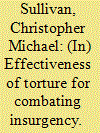

|
|
|
|
|
| Publication |
2014.
|
| Summary/Abstract |
It is commonly believed that torture is an effective tool for combating an insurgent threat. Yet while torture is practiced in nearly all counterinsurgency campaigns, the evidence documenting torture's effects remains severely limited. This study provides the first micro-level statistical analysis of torture's relation to subsequent killings committed by insurgent and counterinsurgent forces. The theoretical arguments contend that torture is ineffective for reducing killings perpetrated by insurgents both because it fails to reduce insurgent capacities for violence and because it can increase the incentives for insurgents to commit future killings. The theory also links torture to other forms of state violence. Specifically, engaging in torture is expected to be associated with increased killings perpetrated by counterinsurgents. Monthly municipal-level data on political violence are used to analyze torture committed by counterinsurgents during the Guatemalan civil war (1977-94). Using a matched-sample, difference-in-difference identification strategy and data compiled from 22 different press and NGO sources as well as thousands of interviews, the study estimates how torture is related to short-term changes in killings perpetrated by both insurgents and counterinsurgents. Killings by counterinsurgents are shown to increase significantly following torture. However, torture appears to have no robust correlation with subsequent killings by insurgents. Based on this evidence the study concludes that torture is ineffective for reducing insurgent perpetrated killings.
|
|
|
|
|
|
|
|
|
|
|
|
|
|
|
|
| 2 |
ID:
132348
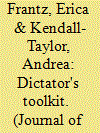

|
|
|
|
|
| Publication |
2014.
|
| Summary/Abstract |
A dictator's motivation for using repression is fairly clear, but why some repress more than others or favor particular types of repressive strategies is less obvious. Using statistical analysis, this article demonstrates that a dictator's reliance on co-optation fundamentally alters how repression is used. Specifically, it finds that co-optation through the use of political parties and a legislature creates incentives that lead dictators to decrease empowerment rights restrictions, like censorship, while increasing physical integrity rights violations, like torture and political imprisonment. This occurs because, by creating parties and a legislature, a dictator draws his potential opposition out of the general public and into state institutions, making it easier to identify who these opponents are, to monitor their activities, and to gauge the extent of their popular support. This reduces the need to impose broad types of repressive measures, like empowerment rights restrictions, that breed discontent within the overall population. At the same time, co-optation creates the risk that rivals, once co-opted, will use their positions within the system to build their own bases of support from which to seek the dictator's overthrow, generating incentives for dictators to increase physical integrity violations to limit the threat posed by these individuals.
|
|
|
|
|
|
|
|
|
|
|
|
|
|
|
|
| 3 |
ID:
132349
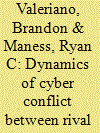

|
|
|
|
|
| Publication |
2014.
|
| Summary/Abstract |
Much discussion of the concept of cyberwar, cyber conflict, and the changing dynamic of future security interactions is founded upon the study of what could be, conjured through spectacular flights of the imagination. The goal of this research article is to exhaustively collect information on cyber interactions between rival states in the last decade so that we can delineate the patterns of cyber conflict as reflected by evidence at the international level. The field of cyber security needs a clear return to social science in order to be able to definitively engage the cyber debate with facts, figures, and theory. To that end we provide a dataset of cyber incidents and cyber disputes that spans from 2001 to 2011. Our data include 110 cyber incidents and 45 cyber disputes. Further, we test our theory of cyber conflict which argues that restraint and regionalism should be expected, counter-intuitive to conventional wisdom. We find here that the actual magnitude and pace of cyber disputes among rivals does not match with popular perception; 20 of 126 active rivals engaged in cyber conflict. The interactions that are uncovered are limited in terms of magnitude and frequency suggesting cyber restraint. Further, most of the cyber disputes that are uncovered are regional in tone, defying the unbounded nature of cyberpower. The coming era of cyber conflict may continue to exhibit these patterns despite fears mentioned in the discourse by the media and cyber security professionals.
|
|
|
|
|
|
|
|
|
|
|
|
|
|
|
|
| 4 |
ID:
132354
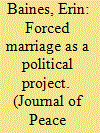

|
|
|
|
|
| Publication |
2014.
|
| Summary/Abstract |
One of the most vexing contradictions about the Uganda originated rebel group, the Lord's Resistance Army (LRA), is the fact that it institutionalized forced marriage on the one hand, while actively discouraging sexually immoral behavior on the other: rape, sexual violence, and promiscuity both within the group and outside it were punishable by severe beating or death. What explains this contradiction? The article suggests that in addition to maintaining discipline and control over a diverse and reluctant group, forced marriage and the regulation of sexual relations reproduced a political project of imagining a 'new Acholi' nation. The article draws on original data collected in focus group discussions with former commanders and wives to commanders to discuss the historical evolution of this vision, how the LRA enforced rules regarding sexual behavior, and finally, the way forced marriage implicated women and girls in the organization of power and domination in the group until it was forced from permanent bases in Sudan in 2002.
|
|
|
|
|
|
|
|
|
|
|
|
|
|
|
|
| 5 |
ID:
132356
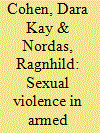

|
|
|
|
|
| Publication |
2014.
|
| Summary/Abstract |
Which armed groups have perpetrated sexual violence in recent conflicts? This article presents patterns from the new Sexual Violence in Armed Conflict (SVAC) dataset. The dataset, coded from the three most widely used sources in the quantitative human rights literature, covers 129 active conflicts, and the 625 armed actors involved in these conflicts, during the period 1989-2009. The unit of observation is the conflict-actor-year, allowing for detailed analysis of the patterns of perpetration of sexual violence for each conflict actor. The dataset captures six dimensions of sexual violence: prevalence, perpetrators, victims, forms, location, and timing. In addition to active conflict-years, the dataset also includes reports of sexual violence committed by conflict actors in the five years post-conflict. We use the data to trace variation in reported conflict-related sexual violence over time, space, and actor type, and outline the dataset's potential utility for scholars. Among the insights offered are that the prevalence of sexual violence varies dramatically by perpetrator group, suggesting that sexual violations are common - but not ubiquitous. In addition, we find that state militaries are more likely to be reported as perpetrators of sexual violence than either rebel groups or militias. Finally, reports of sexual violence continue into the post-conflict period, sometimes at very high levels. The data may be helpful both to scholars and policymakers for better understanding the patterns of sexual violence, its causes, and its consequences.
|
|
|
|
|
|
|
|
|
|
|
|
|
|
|
|
| 6 |
ID:
132351


|
|
|
|
|
| Publication |
2014.
|
| Summary/Abstract |
States involved in territorial disputes have several options with regard to resolving their disputes. What types of states are more likely to resort to legal methods of peaceful resolution in attempting to resolve their territorial disputes? We posit that two separate mechanisms affect states' decisions to choose legal methods of peaceful resolution: the legal mechanism - domestic rule-of-law, and the political mechanism - win/loss record. Rule-of-law based arguments cannot fully explain states' behavior towards arbitration and adjudication. It is the interplay of both of these mechanisms that explains the strategic choices made by states with regards to arbitration and adjudication. We explain why some high rule-of-law states return to binding methods, while others turn to different forums, and why low rule-of-law states consider binding methods. Empirical analyses of all attempts at peaceful resolution of territorial disputes from 1985 to 2006 show that high rule-of-law states are more likely to return to international binding venues only if they have a positive experience with these methods. On the other hand, we find that low rule-of-law states are not concerned with their record of successes/failures when resorting to international binding venues. Overall, the effect of regime type/rule-of-law is conditioned by past successes and failures in international resolution venues.
|
|
|
|
|
|
|
|
|
|
|
|
|
|
|
|
| 7 |
ID:
132352
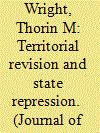

|
|
|
|
|
| Publication |
2014.
|
| Summary/Abstract |
Does involvement in territorial conflict affect domestic repression? I argue that seeking to revise territory abroad will affect domestic repression, but conditionally on regime type and conflict severity. For democracies, there may be public pressure to deliver the good of territory. Because of this, territorial revision can lead to in-group/out-group dynamics at home, making it politically beneficial to increase repression domestically against groups seen as being opposed to the conflict. Autocracies may place a different value on contested territory, as they rely on the distribution of private goods to maintain support. While in-group/out-group dynamics may also be in play for autocracies, such states also face different types of constraints than democracies. Autocracies are more likely to use their military for domestic repression, and thus are more likely to simply maintain or reduce repression because the military is now being used abroad. These propositions are tested cross-nationally by examining repression when states are revisionists in conflicts over territory spanning from 1977 to 2001. The results of ordered logit analyses of state repression show that democratic states become more likely to increase repression when they are territorial revisionists, as those conflict-years become more deadly, while autocratic states are less likely to increase repression during the same periods.
|
|
|
|
|
|
|
|
|
|
|
|
|
|
|
|
| 8 |
ID:
132357
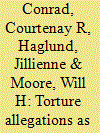

|
|
|
|
|
| Publication |
2014.
|
| Summary/Abstract |
The Ill-Treatment and Torture (ITT) Data Collection Project uses content analysis to measure a number of variables on more than 15,000 public allegations of government ill-treatment and torture made by Amnesty International (AI) from 1995 to 2005. The ITT specific allegation (SA) event data use the torture allegation as the unit of observation, thus permitting users to manipulate them for a wide variety of purposes. In this article, we introduce the ITT SA data. We first describe the key variables in the SA data and report a number of bivariate descriptive statistics to illustrate some of the research questions that might be usefully investigated with the data. We then discuss how we believe the ITT SA data can be used to study not only AI's naming and shaming behavior, but also states' (lack of) compliance with the United Nations Convention Against Torture (CAT). We conclude with an empirical analysis using the SA data that investigates the effect of domestic political institutions on formal complaints, investigations, and adjudication of torture allegations. We show that legislative checks are positively associated with complaints, investigations, and trials; elections and freedom of speech are positively associated with investigations and trials; and powerful judiciaries are associated only with investigations.
|
|
|
|
|
|
|
|
|
|
|
|
|
|
|
|
|
|
|
|
|